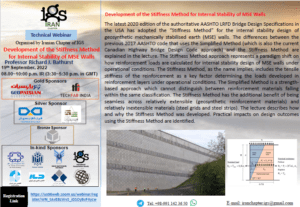IGS Iran Webinar: Development of the Stiffness Method for Internal Stability of MSE Walls by Prof. Richard J. Bathurst
The main lecture in the English language by Prof. Richard J. Bathurst starts at 03:30 PM GMT (03:30~05:30 PM GMT).
The webinar starts one hour earlier (at 02:30 PM GMT) in the Persian language. The session in the Persian language is for people who speak/understand Persian (e.g., Iranian, Afghani, Tajik, Turkoman). The necessary technology checks will begin at 2 pm.
Abstract:
The latest 2020 edition of the authoritative AASHTO LRFD Bridge Design Specifications in the USA has adopted the “Stiffness Method” for the internal stability design of geosynthetic mechanically stabilised earth (MSE) walls. The differences between the previous 2017 AASHTO code that uses the Simplified Method (which is also the current Canadian Highway Bridge Design Code approach) and the Stiffness Method are explained in the lecture. The Stiffness Method approach represents a paradigm shift on how reinforcement loads are calculated for internal stability design of MSE walls under operational conditions. The Stiffness Method, as the name implies, includes the tensile stiffness of the reinforcement as a key factor determining the loads developed in reinforcement layers under operational conditions. The Simplified Method is a strength-based approach which cannot distinguish between reinforcement materials falling within the same classification. The Stiffness Method has the additional benefit of being seamless across relatively extensible (geosynthetic reinforcement materials) and relatively inextensible materials (steel grids and steel strips). The lecture describes how and why the Stiffness Method was developed. Practical impacts on design outcomes using the Stiffness Method are identified.
About the Speaker:
Dr. Bathurst is Professor Emeritus of Civil Engineering at the Royal Military College of Canada where he has taught since 1980 and holds a cross-appointment at Queen’s University at Kingston. He is a past-President of the Engineering Institute of Canada, Canadian Geotechnical Society, International Geosynthetics Society and the North American Geosynthetics Society. Dr. Bathurst has authored or co-authored more than 200 journal papers and 250 other contributions. He has made contributions in the areas of micromechanics of granular soils, railway ballast and track dynamics, pavements, unsaturated soil-geotextile behaviour, constitutive modelling of geosynthetic soil reinforcement materials, new test methods and the development of transparent granular soil surrogates for geotechnical testing. Dr. Bathurst’s current research activities are focused on geosynthetic and metallic reinforcement in earth retaining wall systems, numerical modelling, seismic performance and design of these systems, probabilistic design of reinforced and unreinforced soil structures, reliability-based design, and load and resistance factor design (LRFD) calibration of soil-structures. Dr. Bathurst has served on committees of the Canadian Highway Bridge Design Code and the National Building Code of Canada and AASHTO. He has received national and international awards for his technical contributions and has been invited speaker and keynote lecturer at learned society conferences and symposia on many occasions. Dr. Bathurst is Editor-in-Chief of the peer-reviewed technical journal Geosynthetics International and Associate Editor of the International Journal of Geomechanics and Geotextiles and Geomembranes. He is Fellow of the Canadian Academy of Engineering, the Engineering Institute of Canada and the Canadian Society of Civil Engineering. Dr. Bathurst was elected Fellow of the Royal Society of Canada in 2017.
Zoom Registration Link:
https://us06web.zoom.us/webinar/register/WN_tAvEBzWvS_iDSOyBvF4ycw
For more information please visit Iranian Chapter of IGS Website: http://igs-iran.org




















